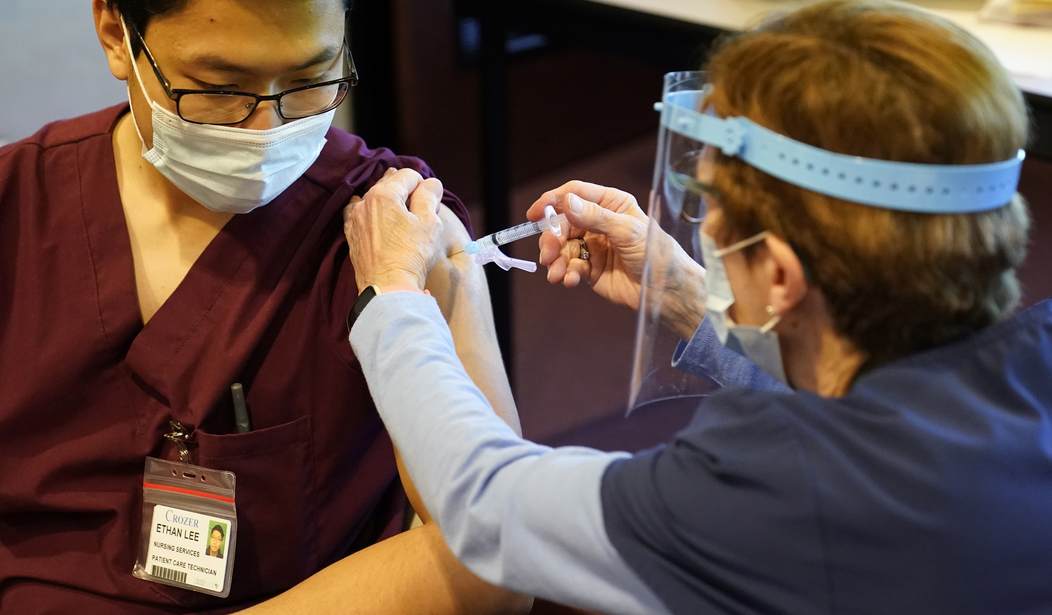Not good but also not surprising given the crazy cocktail of mutations on the variant’s spike protein. Virologist Trevor Bedford made the point this week that if we see a virus spreading very rapidly in an area with a high degree of immunity, it must be the case that that virus is reinfecting lots of people. There just won’t be enough non-immune people to enable rapid spread.
Well, South Africa has a high degree of immunity, although not a high rate of vaccination. Only a quarter of the population is vaccinated but estimates are that 75 percent or higher have already had COVID.
So what are we to make of this freaky spike in new cases over the past two weeks?

On November 23, South Africa had fewer than 900 daily cases. Ten days later it had more than 11,000. Omicron must be reinfecting people who’ve already recovered from COVID to a much greater degree than previous variants did. A new study from South African researchers confirms that it is.
The new Omicron variant of the coronavirus poses a threefold higher risk of reinfection than the currently dominant Delta variant and the Beta strain, a group of South African health bodies said on Thursday…
An analysis of routine surveillance data from South Africa from March 2020 till Nov. 27 showed the “reinfection risk profile of Omicron is substantially higher than that associated with the Beta and Delta variants during the second and third waves,” NICD said in the statement on Thursday.
The graphs from the study speak for themselves. Check out the rise in Gauteng province, the hot spot for Omicron, in the data below. Note the red line, which tracks reinfections, in particular.

In previous waves of COVID in South Africa, reinfections either tracked the overall case curve closely or fell short of it. Not this time:

A professor of biostatistics crunched the numbers on Omicron thus far in this thread, trying to figure out how much of the spread is due to the variant’s hyper-transmissibility among non-immune people and how much is due to it reinfecting people who’d already had some immunity. His conclusion was that there must be a high degree of reinfection for the simple reason that Omicron is spreading so insanely fast that it couldn’t be moving this quickly among a population with as few non-immune people as South Africa has. To do that, it would need to be two or three times as contagious as the measles. The only way it can reach the speed it’s attained is by infecting people who already had some immunity from COVID.
These R values are higher than ever observed throughout the entire pandemic, and now results in superexponential spread (cf figure below, multinomial fit to GISAID sequence data mapped onto NICD case data, with weekday effects smoothed out). pic.twitter.com/kUXG5h0rya
— Tom Wenseleers (@TWenseleers) December 2, 2021
“Superexponential spread.” Bet you didn’t think you’d hear a phrase like that used 21 months into the pandemic and a year after the rollout of the vaccines, huh?
There are two great hopes here. One: Maybe Omicron is mostly preying on people whose immunity has already waned, either because they were infected or vaccinated long ago. If so, people who achieved immunity more recently might be safe(r). Two: Maybe Omicron’s symptoms are milder than those of other variants. South African doctors and health-care executives continue to observe non-threatening symptoms in most of their patients:
Richard Friedland, chief executive officer of Netcare Ltd., which operates the largest private health-care network in South Africa:
“If in the second and third wave we’d seen these levels of positivity to tests conducted, we would have seen very significant increases in hospital admissions and we’re not seeing that. In our primary care clinics it is mainly people under 30-years-old.”
“So I actually think there is a silver lining here and this may signal the end of Covid-19, with it attenuating itself to such an extent that it’s highly contagious, but doesn’t cause severe disease. That’s what happened with Spanish flu.”
“We are seeing breakthrough infections of people who have been vaccinated, but the infections we’re seeing are very mild to moderate. So for health care workers who have had boosters, it’s mostly mild. I think this whole thing has been so poorly communicated and so much panic generated.”
“No one has been even close to being seriously ill,” said one doctor in Cape Town. “But it’s probably too early to tell if this will be a milder variant.” In Norway, there was an Omicron outbreak among 60 people who’d gathered for a Christmas party. None has severe symptoms, although the patients in that case trend young and are believed to be vaccinated.
Don’t celebrate yet, though. The early hype about Omicron cases in South Africa exploding while hospitalizations remained low is quickly being replaced by a more discouraging reality:

You can see that hospitalizations have now begun to take off and are actually outpacing previous waves at the moment. This thread from a health journalist sifting through more data from South Africa is extensive — and alarming. “GP” is “Gauteng province,” epicenter of the Omicron outbreak:
3. Test positivity rates are a good indication of how rapidly a virus is spreading. + rate = nr of tests coming out +.
Over the past week SA’s test +rate for #COVID19 has increased from 1-2% to Thurday’s 22.4%. Increases over the last 3 days have been particularly high. pic.twitter.com/KrYtgovW7b
— Mia Malan (@miamalan) December 3, 2021
6. This table shows the reproductive (R) nr for provinces. It tells you how many people an infected person will infect. It’s concerning when it’s higher than 1.
All SA provinces have an R higher than 1. GP = 2.33.
This means each person in GP will infected more than 2 others. pic.twitter.com/KvR2DGjOG8
— Mia Malan (@miamalan) December 3, 2021
8. By how much have hospital admissions and deaths increased over the past 14 days?
1. The biggest hospital admission increases are in GP (304%), NW (65%) and LP (13%)
2. The biggest hospital death increases are in NW (140%), GP (17%) and EC (16%) pic.twitter.com/g23nZrQw0j— Mia Malan (@miamalan) December 3, 2021
10. Hospital admissions in all districts in Gauteng are not starting to rise rapidly. There are steep week on week increases (blue line in graph = new #COVID19 cases; orange line = new COVID hospital admissions) pic.twitter.com/ZWYieXEwpf
— Mia Malan (@miamalan) December 3, 2021
Hospitalizations are blowing up in the hot spot. Scientists are doubtless digging into that as you’re reading this to see if they can identify commonalities among the patients there with severe illness. How old are they? How many were vaccinated? When were they vaccinated? Were they boosted? If the vaxxed are underrepresented in the hospitalized population, that’ll be a major clue that the vaccines are working. If the vaxxed aren’t underrepresented, that’ll be a major clue that Pfizer and Moderna had better work through the holidays on updating their vaccines.








Join the conversation as a VIP Member